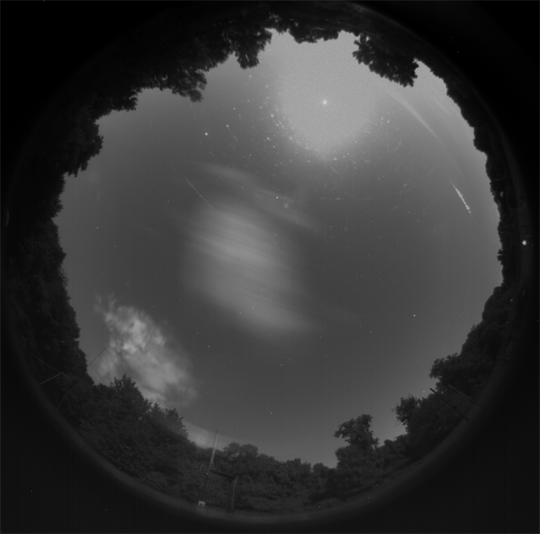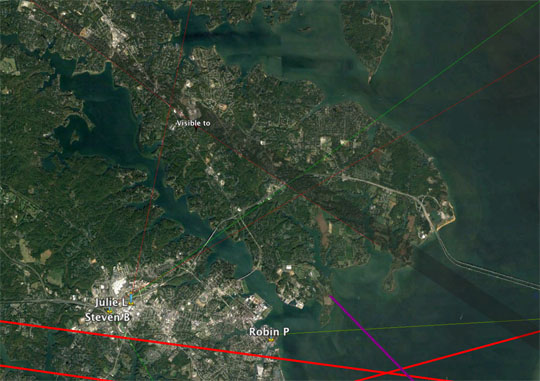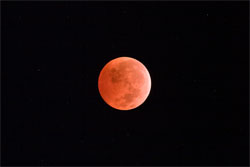Archive for 2017
A Magothy Meteor?
by Mike Hankey, under Comets & Meteors
A bright fireball lit up Maryland’s evening skies Tuesday June 6th near 9:58 PM. Over 50 eyewitnesses from Maryland, Washington DC, Virginia and Pennsylvania reported the event to the American Meteor Society.

AMS Event 2017-1812 – Jun 6th, 2017 @ 21:58 EDT
Two lucky drivers with dashcams rolling captured the meteor on video. One in Kensington MD and another in Springfield VA near the i95 exit on 495.
The University of Maryland College Park Astronomy Department also caught the fireball on their All Sky Camera.
The trajectory of the meteor plotted from the AMS witness reports starts over the Eastern Shore of Maryland near Easton and ends, almost on top of Anne Arundel Community College. This places the meteor’s final flight path directly over the Broadneck Peninsula, which happens to be where I grew up and spent most of my childhood. My personal interest in this event spiked when I realized this.

June 6th Meteor Flight Path Over Broadneck Peninsula – Default AMS Witness Trajectory Estimate
Video Analysis
If you know the location the video was taken from, using Google Earth and Google Street View, you can examine the video and determine the azimuth position of the meteor using ground references caught in the images. For the 495 video, I was able to locate the driver’s position on 495, thanks to him capturing the exit numbers after the meteor went out (thanks for that!). I could then line these up on Google Earth to get my angles.

Springfield Meteor Video Google Earth Calibration
Unfortunately these are only estimates and could be off by up to 5 degrees. There are several factors that can effect this, but an important thing to consider in this analysis, is the true start and end of the fireball most likely were too dim to be caught on film. So the actual start and actual end could be a few degrees off from what we first see. Further, while the Google Earth line-up method does work, it is inherently not perfect. Never the less, any video is better than no video, and all of them provide value in learning where and if a meteorite has fallen.
I was able to do the same analysis for the Kensington, MD Video.

Kensignton Google Earth Calibration
The University of Maryland All Sky Camera picture was much easier to work with because several reference stars were visible. Lining up the image over top of a star chart taken from the location of the observatory and exact time of the fall enables you to ‘solve the picture’ and reduce azimuth and elevation angles. However uncertainty is added to the true start and ending positions due to the light sensitivity of the camera. It is likely part of the early and end flight were not captured by the CCD as they were too dim.
By drawing out the azimuth lines for the start and end points from each camera’s location, one can figure out visually where the lines intersect. Those places will be the start and end of the meteor’s trajectory respectively.
Corroborating Witness Reports
Reducing the azimuth angles from the all sky image and dash cam video corroborates the AMS trajectory while adding a little uncertainty. Did the meteor really fly over Broadneck, or was it farther west closer to DC? Thankfully, three witnesses located in Annapolis MD all reported seeing the meteor over the Severn River, placing it’s path East of Annapolis. These witnesses are the closest to the track on the western side, constraining its location nicely. Unfortunately, there were no reports east of the Bay, so there is more uncertainty there.
AMS Enhanced Trajectory
Solving a fireball’s trajectory from witness reports is not an exact science. People’s minds and eyes are faulty and they can’t always report accurately exactly what they saw. Some are better than others, and some are completely wrong. For these reasons the AMS uses an averaging algorithm and standard deviation formula to attempt to find the best fit for the fireball’s path. This solution can be improved further, by running it a second time and deleting any witness report that is not within 10 degrees of the 1st averaged points (for start and end). If there are enough witnesses this technique can prove to be significantly more reliable than the initial average. This enhanced algorithm is not computed automatically for all AMS events, but for select events it can be run manually. I was pleased to see the output of the enhanced trajectory agreed almost exactly with the video trajectory and also improved on the original average.
This means we have three different trajectory solutions with two different sets of data and all agree within a small margin of error that the meteor flew over the south west side of the Broadneck Peninsula. Considering jet stream winds blow mostly west to east in this part of the world, that would place meteorites, if they fell, all over Broadneck up to and into the Magothy River.
Grain of Salt
Now this meteor wasn’t the biggest, or the brightest meteor ever reported by a long shot and there were no reports of sonic booms (something that usually accompanies a meteorite fall). While magnificent to everyone who saw it, in the grand scheme of things, this was your average everyday kind of fireball. Reportedly not quite as bright as the full moon, if one had to guess its size, a safe bet would be smaller than a basketball before entry into the atmosphere. Now on the positive side, the fragmentation from this event is evident in both the dashcam video and the all sky picture. Each light burst or fragmentation event is evidence of the underlying object breaking apart. These bursts turn the single big rock into dozens, hundreds or even thousands of smaller ones. This is how meteorite strewnfields are created and generally speaking the more fragmentation events the more meteorites there will be.We can see 6-7 bursts in the UMD photograph.
Did meteorites really make it to the ground somewhere in Arnold?
Unfortunately, there is rarely certainty when it comes to meteorite falls, and the only way to know for sure is to go out and look. Now any meteor that is well documented and large enough to drop meteorites will peak my interest, especially those on the east coast or within a few hours drive of my home. But one that potentially landed right where I grew up, yes that’s got my attention. Is it a slam dunk? Certainly not. No significant evidence of a meteor fall was found on the NEXRAD Doppler Radar. While the lack of radar does not mean meteorites didn’t make it to the ground, having radar greatly increases the certainty they did. The radar also tells you exactly where to look. So hunting for a meteorite without Doppler, some would say is a fool’s errand. I don’t necessarily agree with this and believe it is more of a personal choice. Should you quit your job and spend everyday looking for the Magothy meteorites? Probably not. Is it worth keeping an eye out while you work in your yard, walk your dog or go for a jog? Absolutely. The more people who are aware and the more people who are looking, the greater the chances that someone will make a find, if there is one to be had. So if you live in the Arnold area, especially in or near Cape St. Clare, anywhere along College Parkway or really the north side of Route 50, please be aware — there could be meteorites in your yard, driveway, street, or local parks and beaches.
Is it worth looking for them?
Considering only 4 meteorites have ever been found in the state of Maryland, and the last one was found in 1919, the simple answer is : YES. It is worth looking for meteorites from a new fall in Maryland, especially if there is a possibility of meteorites falling and a search area that is fairly well constrained. A meteorite found in Arnold would be the first meteorite found in Maryland in almost 100 years and would certainly be worth its weight in gold. More importantly freshly fallen meteorites possess scientific value that can lead to new discoveries about our solar system and how it evolved.
What to look for?
Meteorites are black and shiny when newly fallen. They will have a thin black skin around them called a fusion crust. It may cover the entire stone, or part of it. Closely examining the crust can reveal flow lines and other signs of the melted material being blown off the rock as it traversed the atmosphere. Meteorites will be heavy for their size and attract a magnet.
How to tell right from wrong
Meteorites will not have holes, or pox marks in them. There are many man made rocks called slag, that people mistakenly think are meteorites.
Slag is easy to identify once you understand what it is and what it looks like. Slag is what is left over from melting rocks for metal refinement, so it looks burnt and melted and it is also usually black. Slag almost always has little holes or air bubbles that solidified in the rock as it cooled. Meteorites won’t have holes in them.
If you’ve found a rock in Arnold that you think might be a meteorite, you can send me pictures of it and I can help you determine if it is or is not a meteorite. You can send pictures to mike.hankey at gmail.com











